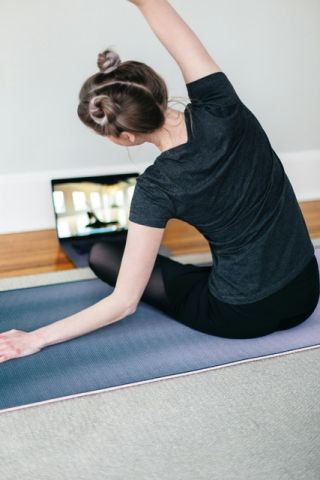Mindfulness
Yoga: How Do I Love Thee? Let Me Count the Ways
3 unexpected benefits, 3 busted myths, and 3 jumpstarts for practice.
Posted July 23, 2024 Reviewed by Monica Vilhauer
Key points
- Contrary to popular belief, anyone, at any age, can enjoy yoga.
- Benefits span mental and physical health, including help for chronic illness, depression, trauma, and anxiety.
- Beginning a yoga practice is not as intimidating as it may seem.

You’ve got to respect a five-thousand-year-old practice thriving across the globe. But it’s not until recently that science has begun to document yoga’s benefits, and there’s still a lot of hype out there. Here’s some of what you need to know—about what yoga can do for you, the myths that might be holding you back, and how to start that practice you’ve been wanting.
Crucial yoga benefits you may not know
- The physical benefits aren't just about strength. Sure, yoga is weight-bearing and improves strength. We’ve heard it can help arthritis, low back pain, and scoliosis (it’s true). Did you know it can also decrease cortisol (the stress hormone), improve immune function, and reduce blood sugar in adult-onset diabetes? Yoga improves heart rate variability (a marker of heart health) and helps conditions as variable as irritable bowel syndrome and menopause. Yoga even offers a welcome adjunct to cancer treatment.
- Yoga improves self-regulation, attention, and executive function. Yoga helps down-regulate the autonomic nervous system, which improves stress. This helps us react less emotionally, improving executive function, memory, and even pain tolerance. Yoga improves mood and allows us to slow down, enhancing problem-solving and decision-making capacities. It’s not unusual to notice a solution to a problem rise to mind during yoga, seemingly out of nowhere. Presto!
- Want social connection? Try yoga. If you regularly attend class, you begin to know others and experience social benefits, even if you never speak to anyone. And you have a ready-made community with like interests and values. But that’s not all. The simple breathing of yoga—inhaling and exhaling during movement—calms the endocrine system, leading to release of prolactin and oxytocin, well-known bonding hormones. Yoga encourages us to feel social, calm, and self-compassionate.
Yoga myths you can abandon today
- I’d have to be in better shape/younger/more flexible/thinner (insert-your-concern-here) to do yoga. Yoga is designed for anyone, at any time. Of any ability, age, or demographic. And it doesn’t even need to cost you anything. There is chair yoga for older adults or the less flexible; adaptive yoga for those with disabilities; wheelchair yoga; yoga designed for those with eating disorders or those practicing healthy at every size. It’s all about finding the right fit (see below), which is easier than you think.
- There is no way I can find an hour for class, let alone commuting and finding childcare—just thinking about it tires me out. You don’t have to go to class to do yoga. Thanks to the internet, you can search for “five minute yoga for…” just about anything you like. Start with five minutes once a week. If you’ve never done yoga, try “five minute yoga for beginners” and go from there. If you sprinkle a couple five-minute practices in a week, you may see your habit take flight. And, luckily for you, yoga is helpful for fatigue, and insomnia, too.
- I already exercise, I don’t need yoga. That may be true. Exercise confers so many benefits. But does your workout help when you’re injured, or prevent injuries? Does it help you increase your mind-body connection, pain tolerance, or decrease headaches? Does it improve general well-being? Help combat anxiety, depression, trauma? If so, you’re right, you don’t need yoga. If not, you may want to “cross-train” with a yoga practice every now and then and see if you like it. What have you got to lose?
How to get started
- Yoga can feel intimidating; don’t let it. Even if you’d like to try in-person classes with social contact and connection, maybe you’re put off by too many images of steamy, sweaty, well-toned bodies in tight leggings. Or you don’t even have a pair of sweats or a mat. No matter. Ignore the bigger yoga studios for now. Take that online class or five-minute routine. If it's recorded, no one can even see you. If you get the courage up to try an online class in real-time, turn your camera off if you prefer. And if you have the wits for an in-person class, try a community center first, or yoga at the gym, where all levels of students—and classes—tend to be available.
- Look for keywords, like “beginner” and “alignment.” There are a dizzying number of yoga “schools” out there— Iyengar, Hatha, Vinyasa; Power, Restorative, Bikram (this last, “hot yoga,” is not recommended for beginners). Ignore the labels at first. Yes, Iyengar has a reputation for focus on alignment, but other forms focus on alignment—which helps prevent injuries—as well. For beginners, a general class is best, with a focus on whatever you want. Sleep, energy, flexibility? Google it. Strength, calm, better mood? It’s at your fingertips. Pregnant or postpartum? Yoga’s got you. Let your body be your guide. Soreness after yoga is fine, pain during or after is not. If it feels good, you can keep doing it.
- Nothing beats the buddy. When you’re ready to try a group class, or even online in real-time, try it with a friend who wants to start yoga as well. Already have a friend who does yoga, but is no longer a beginner? Text or talk to them, they’ll encourage and reassure you on your way.
There’s a reason yoga is so popular in so many cultures, and also a reason it’s called “practice.” There’s no endpoint, we’re all somewhere along the path. Even a tiny bit of yoga can change your mood, perspective, or attitude. Plus, it may be positively addictive. In just five minutes—why not?

References
Brems C. Yoga as a Mind-Body Practice. In: Nutrition, Fitness, and Mindfulness. Springer International Publishing; 2020. p. 137–55. 10.1007/978-3-030-30892-6_10
Canning K. Yoga May Be Even Healthier Than You Thought. Here’s Why. WebMD. 2024; Accessed Jul 21, 2024. https://www.webmd.com/fitness-exercise/news/20240206/yoga-healthier-tha….


